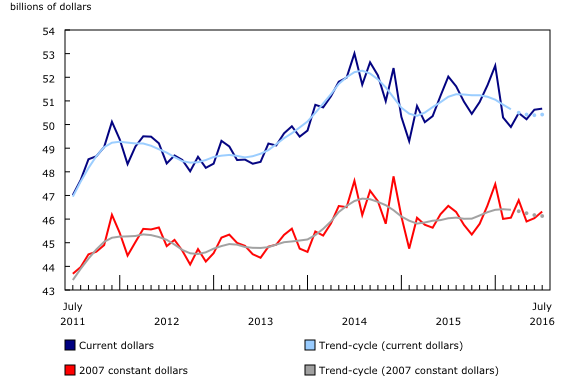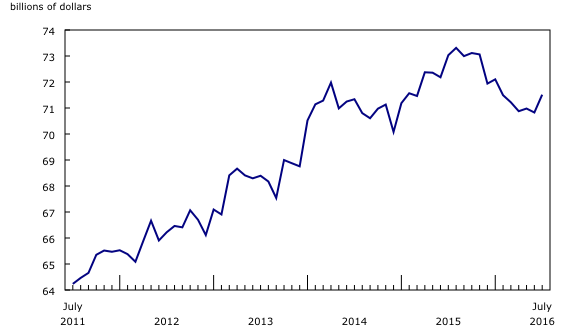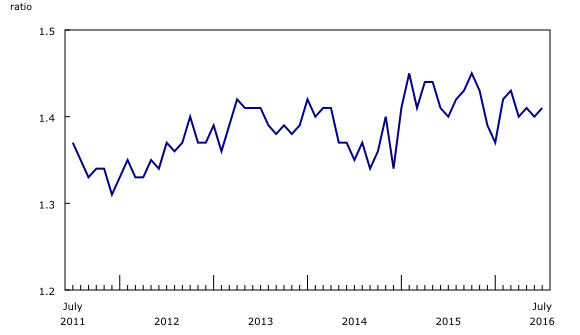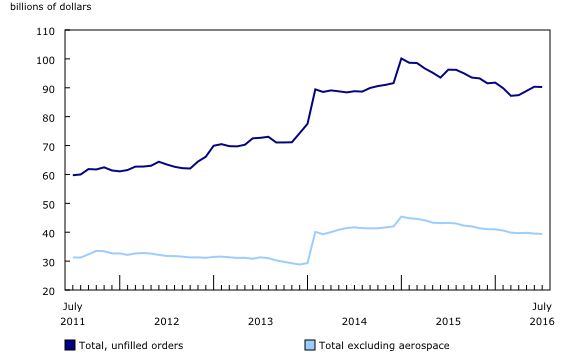Monthly Survey of Manufacturing, July 2016
Archived Content
Information identified as archived is provided for reference, research or recordkeeping purposes. It is not subject to the Government of Canada Web Standards and has not been altered or updated since it was archived. Please "contact us" to request a format other than those available.
Released: 2016-09-16
Manufacturing sales edged up 0.1% in July to $50.7 billion. Higher sales in the food, petroleum and coal products, and primary metals industries were largely offset by a decrease in the production of aerospace product and parts, and by lower machinery sales.
Overall, sales were up in 9 of 21 industries, representing about 54% of the manufacturing sector. Non-durable goods rose 1.0% to $23.6 billion, while durable goods decreased 0.7% to $27.0 billion.
Constant dollar sales increased 0.6%, indicating that a higher volume of goods was sold in July.
Sales gains largely offset by declines
In the food industry, sales rose 1.9% to $8.5 billion in July, partly reflecting increases in the grain and oilseed milling industry, as some manufacturers had reported difficulties acquiring canola in the previous two months.
Manufacturing sales in the primary metals industry were up 2.9% to $3.7 billion. The increase was largely concentrated in non-ferrous metal production, and alumina and aluminum production and processing. Prices for primary non-ferrous metal products contributed to the gain, rising 5.3% in July, according to the Industrial Product Price Index.
Sales of petroleum and coal products rose 2.5% to $4.3 billion in July, following two consecutive monthly declines. The increase was largely the result of higher volumes at several oil refineries. Prices for petroleum and coal products, as measured by the Industrial Product Price Index, were down 3.5% in July.
Production in the aerospace product and parts industry was down 9.0% to $1.5 billion in July, a second consecutive monthly decline. Aerospace production has a tendency to be more volatile compared with the manufacturing sector as a whole. Therefore, the decrease in July was not unusual for the industry, as sales are often lower at the start of each quarter. The increase of goods in process was also lower than normal in July; goods in process are a key component in the calculation of the production value.
Sales in the machinery industry fell 3.3% to $2.6 billion in July, following gains in June. Manufacturers in the commercial and service machinery, agricultural, construction and mining machinery, and industrial machinery industries reported lower sales.
Motor vehicle parts sales fell 2.5% to $2.5 billion in July, after increasing 4.6% in June. Despite a shorter shutdown at parts manufacturers this July, declines in the sales of motor vehicle parts were greater than expected, contributing to the decrease in seasonally adjusted sales for the industry.
Sales up in five provinces
Sales were up in five provinces in July, with Quebec recording the largest gain in dollar terms, followed by British Columbia.
Manufacturing sales in Quebec were up 0.9% to $11.9 billion in July, the fourth consecutive monthly rise. A 12.4% gain in sales in the chemical industry was largely responsible for growth in the province. The primary metals, food, and fabricated metal products industries also recorded higher sales. The increases were partly offset by a 5.7% decline in the transportation equipment industry.
In British Columbia, sales rose 2.2% to $3.8 billion in July, reaching their highest level since February 2006. The gain was largely attributable to higher sales in the paper industry (+12.9%), after some establishments reported maintenance shutdowns in June. A 4.6% increase in the wood products industry also contributed to the gain in July.
Sales fell 1.5% in Alberta, reflecting lower sales in the chemical industry, which more than offset the strong gain in the petroleum and coal product industry.
Inventory levels rise
Manufacturing inventories increased 1.0% to $71.5 billion in July, the highest level since January 2016. Inventories rose in 11 of 21 industries.
The petroleum and coal products industry (+7.1%) posted the largest increase in inventories. Higher inventories in the primary metals (+2.5%) and chemical (+2.2%) industries also contributed to the overall gain. These rises were partly offset by lower inventory levels in the transportation equipment industry (-1.1%).
The inventory-to-sales ratio increased from 1.40 in June to 1.41 in July. This ratio measures the time in months that would be required to exhaust inventories if sales were to remain at their current level.
Unfilled orders edge down
Unfilled orders edged down 0.1% to $90.3 billion in July, after three consecutive monthly gains. The decline was mainly the result of lower unfilled orders in the transportation equipment industry (-0.5%).
New orders were down 2.9% in July, following three consecutive monthly gains. New orders declined in the aerospace product and parts, and fabricated metal products industries.
Fort McMurray wildfire and evacuation
For the third month in a row, the Monthly Survey of Manufacturing added three supplementary questions to a sample of about 3,600 respondents in July to assess the impact of the Fort McMurray wildfire and evacuation on manufacturing activities in Canada. About 39% of firms answered the supplementary questions, mainly through telephone interviews.
According to the responses to the supplementary questions, 85 manufacturers in July (2.5% of the total sample) were affected by the wildfire and evacuation in Fort McMurray, compared with 118 manufacturers in June and 194 in May. Among the 85 manufacturers affected by the wildfire, 34% were able to quantify the effect in terms of dollar value or percentage on manufacturing sales. The remaining 66% reported that they were affected, but were unable to quantify the impact. The share of firms that were affected by the wildfire and that quantified the impact was 38% in June and 40% in May.
At the industry level, the impact of the Fort McMurray wildfire and evacuation on manufacturing activities was more pronounced in the fabricated metal products industry and machinery industry. In total, 14 firms in the fabricated metal products industry and 12 firms in the machinery industry reported that their manufacturing sales were lower in July. In contrast, 3 firms in the machinery, transportation equipment, and miscellaneous manufacturing industries reported higher sales in July as a result of demand originating from Fort McMurray.
From a provincial perspective, close to 50% of manufacturing firms affected by the Fort McMurray wildfire were located in either Alberta or Ontario. Specifically, 22 manufacturers in Alberta and 20 manufacturers in Ontario indicated that their sales in July were affected by the wildfire and evacuation.
The number of affected firms in British Columbia, Manitoba, Quebec, Saskatchewan and the Atlantic provinces was relatively small. As with the responses to the supplementary questions in May and June, it was difficult to determine the overall impact of the wildfire and evacuation on manufacturing sales and inventories in dollar terms in July, given that 66% of respondents affected by the incident could not quantify the impact.
Note to readers
Monthly data in this release are seasonally adjusted and are expressed in current dollars unless otherwise specified. For information on seasonal adjustment, see Seasonally adjusted data – Frequently asked questions.
For information on trend-cycle data, see Trend-cycle estimates – Frequently asked questions.
Non-durable goods industries include food, beverage and tobacco products, textile mills, textile product mills, clothing, leather and allied products, paper, printing and related support activities, petroleum and coal products, chemicals, and plastics and rubber products.
Durable goods industries include wood products, non-metallic mineral products, primary metals, fabricated metal products, machinery, computer and electronic products, electrical equipment, appliances and components, transportation equipment, furniture and related products, and miscellaneous manufacturing.
Production-based industries
For the aerospace and shipbuilding industries, the value of production is used instead of the value of sales of goods manufactured. The value of production is calculated by adjusting monthly sales of goods manufactured by the monthly change in inventories of goods in process and finished products manufactured. The value of production is used because of the extended period of time that it normally takes to manufacture products in these industries.
Unfilled orders are a stock of orders that will contribute to future sales assuming that the orders are not cancelled.
New orders are those received, whether sold in the current month or not. New orders are measured as the sum of sales for the current month plus the change in unfilled orders from the previous month to the current month.
Manufacturers reporting in US dollars
Some Canadian manufacturers report sales, inventories and unfilled orders in US dollars. These data are then converted to Canadian dollars as part of the data production cycle.
For sales, based on the assumption that they occur throughout the month, the average monthly exchange rate for the reference month (noon spot rate) established by the Bank of Canada is used for the conversion. The monthly average exchange rate is available in CANSIM table 176-0064.
Inventories and unfilled orders are reported at the end of the reference period. For most respondents, the noon spot exchange rate on the last working day of the month is used for the conversion of these variables. However, some manufacturers choose to report their data as of a day other than the last day of the month. In these instances, the noon spot exchange rate on the day selected by the respondent is used. Note that because of exchange rate fluctuations, the noon spot exchange rate on the day selected by the respondent can differ from both the exchange rate on the last working day of the month and the monthly average exchange rate. Noon spot exchange rate data are available in CANSIM table 176-0067.
Revision policy
Each month, the Monthly Survey of Manufacturing releases preliminary data for the reference month and revised data for the three previous months. Revisions are made to reflect new information provided by respondents and updates to administrative data. Once a year, a revision project is undertaken to revise multiple years of data. During annual revisions, changes are made to seasonal adjustment parameters.
Real-time CANSIM tables
Real-time CANSIM tables 304-8014, 304-8015 and 377-8009 will be updated on September 27. For more information, consult the document Real-time CANSIM tables.
Next release
Data from the August Monthly Survey of Manufacturing will be released on October 18.
Contact information
For more information, contact us (toll-free 1-800-263-1136; 514-283-8300; STATCAN.infostats-infostats.STATCAN@canada.ca).
To enquire about the concepts, methods or data quality of this release, contact Bechir Oueriemmi (613-951-7938; bechir.oueriemmi@canada.ca) or Michael Schimpf (613-863-4480; michael.schimpf@canada.ca), Manufacturing and Wholesale Trade Division.
- Date modified:







